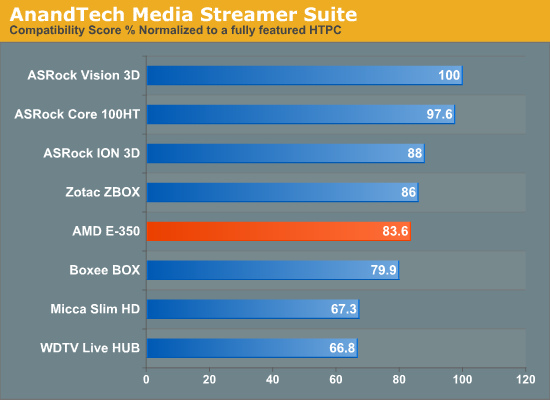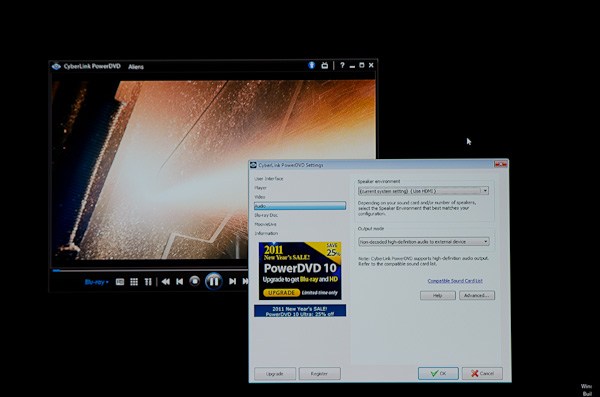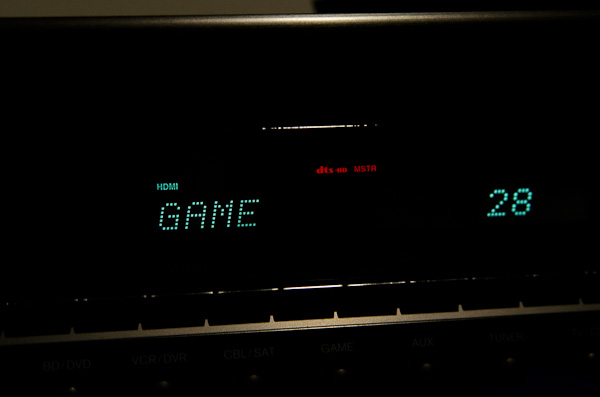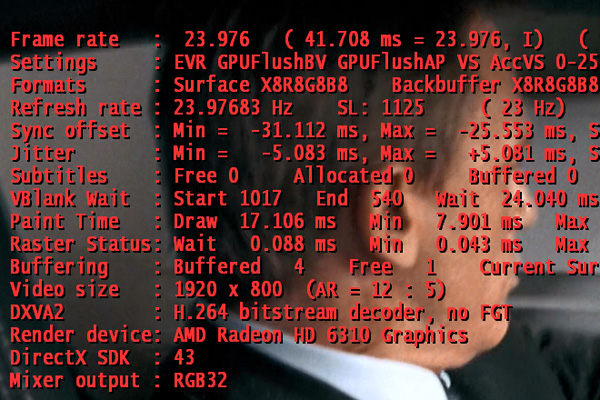The Brazos Review: AMD's E-350 Supplants ION for mini-ITX
by Anand Lal Shimpi on January 27, 2011 6:08 PM ESTVideo Decode Capabilities: Is Brazos the New ION?
While Atom may have been the right product at the right time, it was a very conservative architecture paired with a very conservative platform. For netbooks and nettops Intel chose to assume no risk at all, pairing Atom with the proven 945 chipset. As a result, it left a lot of room for innovation - something NVIDIA saw and capitalized on with ION.
While VIA created the mini-ITX form factor, it was really NVIDIA that made it interesting. The first mini-ITX ION platforms gave you almost everything you needed to build a fully capable HTPC. For video playback, with NVIDIA’s GPU (or at least its fixed function decode pipeline) doing the heavy lifting, the fact that you had an anemic Atom a couple centimeters away didn’t matter. The problem with ION is that it had no future. Without a DMI license, NVIDIA would not be able to build future versions of ION for Atom’s successors. Even after the settlement it’s unlikely we will ever see modern versions of ION, especially considering that Intel’s 2011 Atom platform (Cedar Trail) will finally integrate H.264 decode acceleration in Q4.
Where Intel is conservative, AMD will innovate. Brazos adds a number of advantages from a media standpoint over Atom. There’s native HDMI support and a full implementation of AMD’s UVD3 decode engine supporting hardware H.264, VC-1 and MPEG-2 acceleration. Although both of these advantages are also enjoyed by ION the next feature isn’t. Brazos supports Dolby TrueHD and DTS-HD MA bitstreaming over HDMI. From a feature standpoint, Brazos is even more complete than ION.
I ran MSI’s Brazos board through our Media Streaming compatibility suite. Below is Brazos’ compatibility score compared to the other devices and HTPCs we’ve put through the suite:

Failed Tests
- 1080p60 60 fps L5.1 H.264
- L5.1 H.264 (16 reference frames)
- FLAC, ASS Subs - High CPU Utilization
- HD Real Media
- Deinterlacing
Numerically, Brazos actually falls behind ION. Allow me to explain why. Our Media Streaming suite tests virtually everything you might throw at a HTPC. When it comes to the most commonly found content, Brazos excels. It can handle Blu-ray discs (although there’s no Blu-ray 3D support), it can deal with 1080p x264s commonly found online and it even accelerates Flash video (more on this later). Brazos’ UVD3 however is tied to clock speed, and the GPU clock of the Radeon HD 6310 is pretty low at 500MHz. As a result, Brazos fails certain tests. The platform is incapable of accelerating and playing back 1080p60 H.264 video. Very little content falls into this category, however if you want to play it you can’t on Brazos. The good news is 1080i60 works just fine.
Brazos’ GPU also fails all of our deinterlacing tests, something we noticed in reviews of AMD’s entry level GPUs. The higher end models don’t have an issue here but the lesser equipped models do. Again, chances are that you won’t want to watch interlaced content on your Brazos HTPC so this is likely not a big issue.
The other shortcomings are videos with components that aren’t accelerated by UVD3. For example, HD Real Video chugs on Brazos as does our heavy FLAC + ASS subs test. If you’re playing non-3D Blu-ray content or 1080p24 x264s you find on the web, Brazos will easily fit the bill. It’s the more eccentric content that you’ll run into CPU limitations with.
Since the Radeon HD 6310 is derived from AMD’s desktop GPUs we get full 23.976 fps support when you select 23Hz in AMD’s Catalyst driver:
Selecting 24Hz yields a 24.000Hz refresh rate.
As I mentioned earlier bitstreaming both TrueHD and DTS-HD MA are supported over HDMI:














176 Comments
View All Comments
Belard - Tuesday, February 1, 2011 - link
It would fail at bluRay 3D.the 1080i is a bit unimportant since flatscreen TVs don't do interlace.
doctorpink - Tuesday, February 1, 2011 - link
if i remember correctly, nano runs 1.8ghz and is much faster but more power hungry...are there netbooks with nano anyway?
grego3d - Tuesday, February 1, 2011 - link
I'm sold on this Sandy Bridge / Atom killer. Well, maybe not Sandy Bridge killer yet, but i'm sure the second generation fusion processors will be. Now I need help finding a great little mini-itx case. I'd love to build a mini pc the size of my Wii. I have found a few small cases, but where on earth are the slot feed DVD/BD players. I always start my daily reading right here @ Anandtech.com so please save me some time and help us all out by rounding up a case review for this new Fusion platform. Go AMD Fusion - Boo Intel (and your 1$Billion oops!)Belard - Tuesday, February 1, 2011 - link
Sure is such excitement over such a tiny chip.It also reminds me why one of the P4s Dells I use at work is sooooooooooo Slooooooooooooooow.
I'll admit I'm using my very old computer (AMD X2 3800) as an HTPC somewhat, since it wasn't worth selling when I upgraded. But its a 90watt CPU... so saving power is the big thing, eh?
lovansoft - Tuesday, February 1, 2011 - link
I've got an Acer Aspire 5517 with an AMD Athlon tk-42 processor and integrated HD3200 video. It's also 1.6 Ghz so I wanted to showcase a relative clock for clock comparison. It is a 20W chip with 1meg cache built on a 65nm process and no VT. It's not an Athlon II, just an Athlon 64 x2, I believe.On Cinebench R10:
Single Thread: E-350=1174, TK-42=1340 :-: 1174/1340 = 87.6%
2 Threads: E-350=2251, TK-42=2373 :-: 2251/2373 = 94.4%
(1174+2251=3425)/(1340+2373=3713) = 92.2%
Scaling seems better on the new chips than on the older ones.
At idle with the screen off the laptop pulls about 18 watts. In Cinebench on a single thread it pulls about 30 watts, with 2 threads it pulls about 33 wats. Opening the screen to run the LCD at full brightness adds about 9 watts at any time.
I ran these tests with a Kill-A-Watt meter. It's not quite an exact comparison, but is pretty close. But to see that they kept performance close, added graphics, and still managed to shave 10% off TDP it's pretty dang impressive.
lovansoft - Tuesday, February 1, 2011 - link
Actually, I just let my laptop sit idle for a while. Now, idle power usage dips down to 11 watts with the lid closed and generally stays switching between 11-13 watts. Hmmm, the power usage on these new chips aren't quite as I would expect unless it's a platform thing. This article shows that the new chips pull 9W at full load under Cinebench. My testing shows I ramp from about 12W up to 33W which is a 21W increase by taxing the TK-42, right inline with the 20W spec giving my rounding of numbers. All other parts being equal and I only ramp up 9W instead of 21W then my peak should be about 12W less, or about 21W total instead of 33W total. That would be a significant gain. Interesting that this article has the new platform at 32.2W with the same workload. That's about 50% higher than my rough estimations. Is it because it's a desktop board and not a laptop design?sebanab - Wednesday, February 2, 2011 - link
Thanks for the performance comparison. I really helps putting the Zacate into perspective.On the power consumption comparison:
Ofcourse the desktop board system will consume more than a laptop with same specs.
Your laptop consumes less because of different PSU , less USBs , less components in general (PCIex) and so on.
So in order to make a correct comparison , wait for a HP DM1z review for example.
lovansoft - Wednesday, February 2, 2011 - link
I figured as much, but 50% seems high. But then again, it really is only a few watts... Lower efficiency PSU, a couple more chips to provide some extra ports. A couple of watts here and there do add up I suppose. And to think it provides more than 90% of my current performance into only 2/3 the power. I'd think if they can up it to 2Ghz it'd be about the same as mine without tapping the power too much. From the speculation I've read, it makes it seem that the revision coming in a year should grow the performance by quite a bit without really increasing power, about what you'd expect from a die shrink.You know, with this architecture, it'd be nice if a board could be made that would have multiples of these chips for server use. From my experience in SMB, I rarely find servers being CPU bound. Usually if they are, then there is some runaway process that needs to be tamed. Maybe this current generation isn't quite fast enough, but with a process shrink and some speed adjustments, getting a few of these on a board would make a very low energy server. But it'd only be feasible if there were something they could use that built in graphics portion for. Otherwise it'd be a waste.
Oh, and Cinnebench R10 on an AthlonXP 3000+ (2Ghz) = 1438.
Single Thread: E-350=1174, XP3000=1438 :-: 1174/1438 = 81.6%
1.6/2=80% Seems to be about the same IPC as the AthlonXP line.
I don't have power numbers for it, though.
torkemada - Wednesday, February 2, 2011 - link
Is E350IA-E45 board HDMI 1.4? Info on the net is confusing.Hrel - Thursday, February 3, 2011 - link
that VIA chip is pretty impressive.